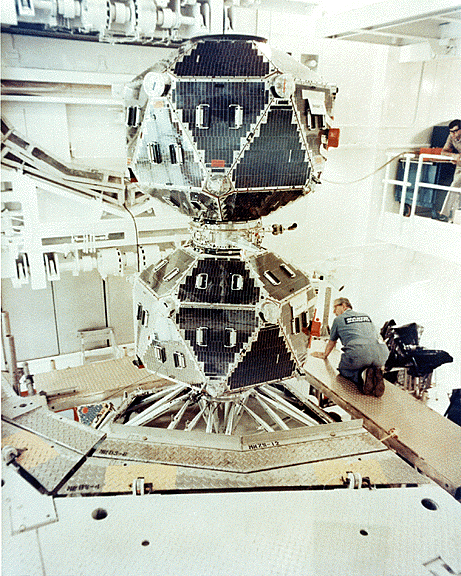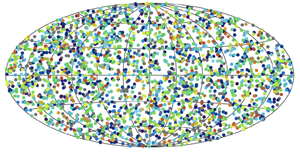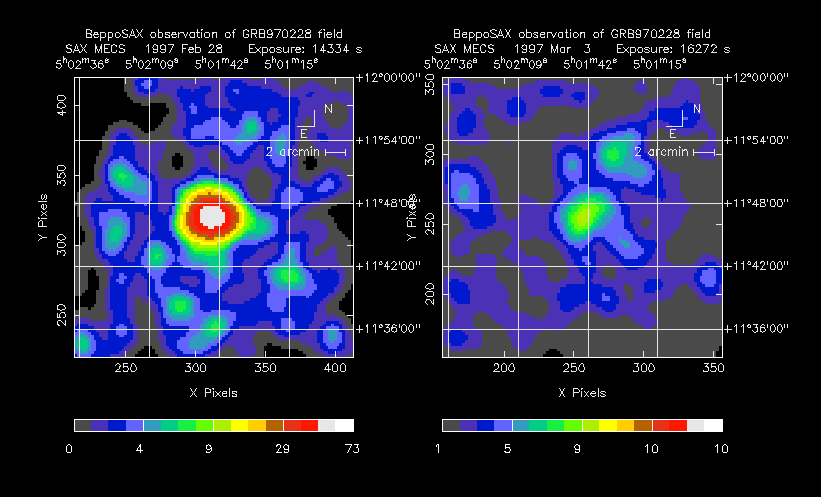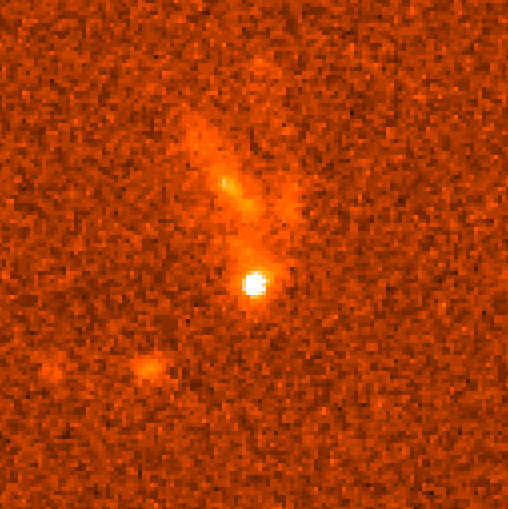Gamma-Ray Bursts

One of the Vela 5 satellites in a clean room. (Credit: Los Alamos National Laboratory)
First Discovery and Early Observations
During the 1960s, the United States Air Force launched a series of satellites, the Vela satellites, to monitor compliance with the Nuclear Test Ban Treaty. These satellites were sensitive to gamma-radiation, since a nuclear blast in the Earth's atmosphere would produce a large amount of gamma-rays. Fortunately, no violations of the treaty were detected. Instead, they witnessed mysterious flashes of gamma-rays produced outside our solar system!
The first gamma-ray burst (GRB) detection in the Vela data dates to July 1967; however, because of security concerns, it wasn't until 1973 that Ray Klebesadel, Ian Strong and Roy Olson of Los Alamos National Laboratory published their discovery. That first paper reported 16 GRBs that occurred between July 1969 and July 1972.
Early gamma-ray detectors were not capable of localizing the source of gamma-rays on the sky very accurately. There were ways of getting around this by triangulating the detections from several different widely spaced gamma-ray detectors. However, even by triangulating the detections, it was not possible to tell how far away the bursts were occurring.
The lack of distance information led to two very different classes of theories about where GRBs come from. One theory was that GRBs occur at cosmological distances (i.e. hundreds of millions to billions of light-years away). However, most astronomers favored a scenario in which GRBs occur much closer to Earth, since this would make the GRB's energy output easier to explain. One such theory was that GRBs originate from neutron stars within the Milky Way.
Enter the Compton Gamma-Ray Observatory
In 1990, the Compton Gamma-Ray Observatory (CGRO) was launched. Onboard was the Burst And Transient Source Experiment (BATSE) which could monitor nearly the entire sky for gamma-ray transient sources (i.e., sources that suddenly gave off a large amount of gamma-rays, like gamma-ray bursts, and then faded). In addition, BATSE could localize where in the sky the burst was coming from.
Within a few years, BATSE had observed several hundred bursts. When these bursts were mapped on a projection of the sky (like stretching out a globe), it became obvious that the bursts were not confined to the plane of the Milky Way galaxy.
The following is an map of a gamma-ray emission line of 26Al in the Milky Way obtained by the COMPTEL instrument on CGRO. Notice that it is concentrated along the plane of the Milky Way. If GRBs originate from our Galaxy, we would expect their distribution to look a lot like this:

26Al emission from the Milky Way (Credit: COMPTEL collaboration)
However, this is what the GRB distribution really looks like:

BATSE skymap of the GRB distribution. (Credit: BATSE team)
In fact, GRBs came from all directions. This was a big blow to the theory that GRBs originate in neutron stars in the Milky Way. However, there was still room for GRBs to occur within our Galaxy. Reluctant to put GRBs at cosmological distances because of the energy requirement mentioned earlier, astrophysicists postulated that GRBs might occur in our Solar System's Oort cloud. Of course, the possibility of an extragalactic GRB origin also remained. Without GRB distance measurements, it was impossible to rule out either theory.
BeppoSAX and the GRB Afterglow
In 1997 BeppoSAX, an Italian X-ray satellite, detected X-ray "afterglow" from a gamma-ray burst (GRB). This afterglow is radiation emitted after the initial burst of gamma-rays. Afterglow can usually be seen in the X-rays, optical, and radio wavelengths. Most of what is known about GRBs comes from afterglow observations.
The discovery of afterglow made redshift measurements possible. The redshift of an object is a measurement of its distance. At last astronomers could determine how far away GRBs were. In fact, all of the GRBs that have had their redshifts measured are at cosmological distances. The furthest occurred at a redshift of about 4.5, which translates to a distance of a few billion light years!

BeppoSAX images of GRB 970228 eight hours after the burst (left) and three days after the burst (right). (Credit: BeppoSAX team)
The images above show the X-Ray afterglow of GRB 970228 made by BeppoSAX. The left panel, taken 8 hours after the burst, shows a strong X-ray afterglow. The right panel, taken 3 days later, shows how the afterglow has faded, but is still detectable.
Host Galaxies
GRB 970228 also heralded the discovery of optical afterglow, which was first observed by the William Herschel Telescope. This optical afterglow fades on timescales of days.
Optical observations of GRB afterglow later brought the discovery of likely candidates for host galaxies of GRBs. Within about two weeks of GRB 990123, the Hubble Space Telescope (HST) observed the sky surrounding the burst. The image below shows the HST view of the rapidly fading optical afterglow of the burst, seen as the bright spot just below the center of the image. Notice the dimmer, extended object above the bright afterglow. That appears to be the host galaxy of GRB 990123! Observations of host galaxies are important because the characteristics of host galaxies might give clues about the nature of the burst.

Hubble Space Telescope Image of the sky surrounding GRB 990123. The bright spot near the center is the fading afterglow, and the diffuse object above it is likely the burst's host galaxy. (Credit: HST GRB Collaboration/NASA)
What Are Gamma-Ray Bursts?
What exactly is a gamma-ray burst? The short answer is that astrophysicists aren't exactly sure, yet. However, there are a couple of theories that have come to the forefront after recent observations. Before moving on, though, it might be helpful to list the things that are known about GRBs:
- GRBs occur randomly on the sky
- From the Earth, we could see about one per day if we were able to watch the entire sky all of the time
- There are two classes of GRB: those that last less than about 2 seconds, and those that last longer than about 2 seconds
- The long bursts occur at cosmological distances; while distances of the short bursts have not been measured
- Given the distance of the long bursts, they must put out about 1053 ergs of energy (if they emit energy equally in all directions)
To get an idea of how much energy 1053 ergs really is, our Sun puts out about 1033 ergs each second. It would take our Sun, then, 880 billion years to put out the same energy as a GRB! For perspective, our Sun will only live to be about 10 billion years, and our Universe is only about 12 billion years old.
Putting the facts together, astrophysicists have narrowed the field to two promising theories for the origin of GRBs: neutron star/neutron star mergers and hypernovae. The truth may lie between these two theories somewhere -- for example, the long bursts may be from hypernovae while the short bursts are from neutron star/neutron star mergers. However, it may also be that GRBs originate from something that astronomers haven't considered yet.
Neutron Star/Neutron Star Merger
As two neutron stars orbit each other, they lose rotational energy to gravitational energy, thus decaying their orbit. (Actually, the orbit of any two bodies decays, but in the case of two neutron stars, it occurs much faster than it would in, say, the Earth-Moon or Sun-Earth system.) Eventually the two neutron stars will collide, forming a black hole and possibly radiating a large amount of energy.
Hypernovae
At the end of a massive star's life (mass greater than about 10 Suns), it dies spectacularly in a supernova explosion, leaving behind a neutron star or black hole. Astronomers have known about supernovae for quite some time. However, if the star is very massive (mass greater than about 40 Suns) the collapse may appear different from a supernova, with an energy output greater than a regular supernova by about 100 times. Such large explosions are called hypernovae, and could be the source of at least some GRBs.



